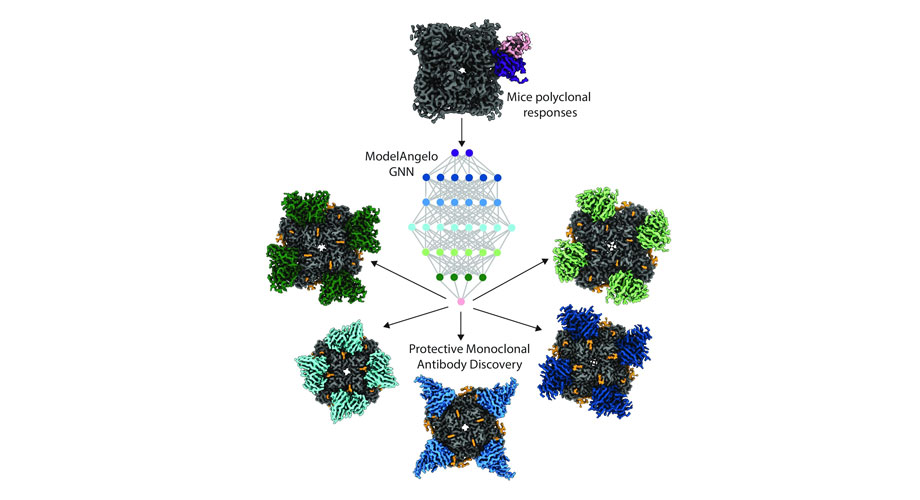AI model helps boost pandemic preparedness
Scripps Research breakthrough reduces antibody discovery time from weeks to hours, potentially revolutionizing pandemic response and therapeutic development.
September 10, 2025
LA JOLLA, CA—Scientists at Scripps Research have developed a novel method that uses artificial intelligence (AI) and advanced imaging techniques to more accurately and efficiently identify therapeutic antibodies to treat infectious diseases.
The breakthrough method, published in Science Advances on August 15, 2025, reduces the time needed to identify protective antibodies from weeks to under a day—while offering a scalable approach that minimizes data bottlenecks and accelerates research. This advancement could transform how researchers develop treatments for influenza, HIV and other infectious diseases, particularly during health emergencies where rapid response is critical.
“This represents a paradigm shift in how we discover antibodies,” says study senior author Andrew Ward, professor in the Department of Integrative Structural and Computational Biology at Scripps Research. “By harnessing AI to analyze the structural details of immune responses, we can now identify the most promising therapeutic candidates in mere hours, with better success rates than traditional methods. This could be game-changing for pandemic preparedness and therapeutic development.”
 Scripps Research scientists used a graphical neural network-based structure building tool, ModelAngelo, to discover monoclonal antibodies (bottom) from polyclonal antibody responses produced after mouse vaccination (top).
Scripps Research scientists used a graphical neural network-based structure building tool, ModelAngelo, to discover monoclonal antibodies (bottom) from polyclonal antibody responses produced after mouse vaccination (top). Credit: Scripps Research
Click here for a high-resolution image.
Finding the needle in a haystack
Antibodies play a critical role in the immune system because of their ability to latch onto and neutralize bacteria, viruses and other pathogens. These large, Y-shaped proteins are naturally produced by the immune system, but can be engineered as treatments for cancer, autoimmune disease and infections. They’re among medicine’s most important therapeutic tools, comprising more than 200 approved drugs worldwide due to their safety and effectiveness in treating diverse diseases.
However, traditional antibody discovery methods are labor-intensive and time-consuming, requiring researchers to screen thousands of candidates individually to find those that bind to the right targets and still provide enough protection. This is because when the body encounters a threat like a virus, it produces a huge, diverse array of antibodies—but only a select few are able to target vulnerable spots that can neutralize the pathogen or provide therapeutic benefit. Sorting through this complexity has historically been a major bottleneck in drug and vaccine development.
AI meets advanced microscopy
Researchers have recently developed a potential solution to this problem by combining two powerful technologies: cryo-electron microscopy (cryoEM), which uses an electron beam to capture images of antibodies binding to their targets at near-atomic resolution, and ModelAngelo, an AI tool that builds molecular models from the cryoEM images and predicts which antibodies could provide protection. Leveraging these two technologies, Ward and his laboratory analyzed the structural patterns of antibody responses, and then used ModelAngelo to identify the most compatible antibodies from its database. This method, known as Structure-to-Sequence (STS), builds on previous findings from Ward’s lab that leveraged cryoEM to rapidly map all of the antibodies elicited by an infection in a matter of days.
“What’s exciting about this method is that it removes much of the guesswork from antibody discovery,” says first author of the study James Ferguson, a staff scientist in the Ward lab. “Instead of randomly screening thousands of antibodies, we can look directly at the immune-response structure and identify the ones that are binding to functionally important sites. ModelAngelo then helps us find these antibodies in genetic databases with remarkable precision.”
To demonstrate real-world therapeutic potential, the team tested the antibodies identified by ModelAngelo in animal models to see how well they protected against influenza. The researchers found that the antibodies identified with the ModelAngelo-powered STS pipeline showed significant protection from the virus—indicating that this method could be a powerful tool to identify the most protective antibodies against disease.
Preparing for the next pandemic
The implications extend far beyond influenza. The method’s speed and accuracy make it particularly valuable for responding to emerging infectious diseases, where rapid development of treatments can save lives.
“The integration of AI with immune response analysis not only accelerates vaccine development but also enhances our ability to respond swiftly to emerging pathogens,” Ward noted. “By streamlining the discovery of protective antibodies, this pipeline paves the way for faster, more targeted therapeutics in the face of future global health threats.”
To build upon their work, the research team has initiated collaborations with labs across Scripps Research to continue studying how ModelAngelo could revolutionize therapeutic antibody development. Ward and his lab envision a future where their method is able to support evolving health challenges, ultimately bringing life-saving treatments to patients faster than ever before.
In addition to Ward and Ferguson, authors of the study, “Functional and epitope specific monoclonal antibody discovery directly from immune sera using cryoEM,” are Sai Sundar Rajan Raghavan of Scripps Research; Garazi Peña Alzua of the Icahn School of Medicine at Mount Sinai; Disha Bhavsar of the Icahn School of Medicine at Mount Sinai; Jiachen Huang of Scripps Research; Alesandra J. Rodriguez of Scripps Research; Jonathan Torres of Scripps Research; Maria Bottermann of MIT and Harvard; Julianna Han of Scripps Research; Florian Krammer of the Icahn School of Medicine at Mount Sinai and the Medical University of Vienna; and Facundo D. Batista of MIT and Harvard.
This study was supported by the Centers of Excellence for Influenza Research and Response (CEIRR) contract # 75N93021C00014), Icahn School of Medicine at Mount Sinai institutional funds (F.K.), and by the National Institute Of Allergy And Infectious Diseases of the National Institutes of Health Award Number P01 AI136621 (A.B.W.).
For more information, contact press@scripps.edu

